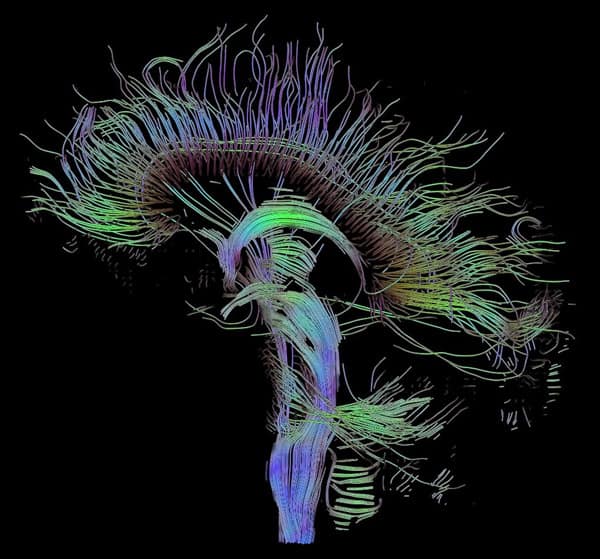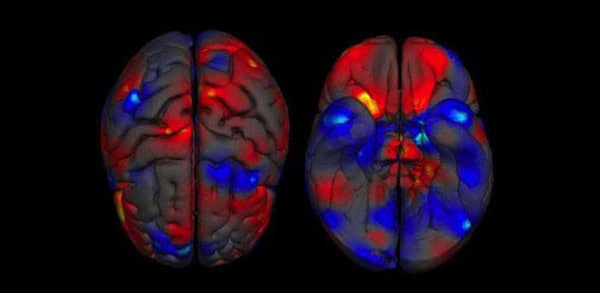Breakthroughs in Intelligence
Jared Taylor, American Renaissance, October 27, 2017
Richard J. Haier, The Neuroscience of Intelligence, Cambridge University Press, 2017, 251 pp., $36.00 (softcover).
This is a first-rate introduction to the biological basis for intelligence. It is so good it is astonishing that Cambridge University Press had the courage to publish it. For half a century, serious investigation of the genetics of intelligence has been virtually taboo, and a few scientists quietly wrote heretical articles for obscure journals.

The Neuroscience of Intelligence brings the latest findings out of obscurity, and bluntly lays out the facts: The human mind is not a blank slate; intelligence is biological; it varies in people for reasons that are overwhelmingly genetic; there is no known environmental intervention — including breast feeding and enriched home environment — that raises IQ; we are beginning to understand the biological mechanisms of intelligence, and before long we should be able to change genes and the brain itself in order to raise intelligence.
The author, Richard J. Haier of UC Irvine, has more than 40 years of research experience in intelligence, and is frustrated by the unwillingness of academics and policy makers to understand or talk about intelligence. He points out that intelligence is central to every social problem — crime, poverty, bad schools, drug addiction — and that the usual liberal panaceas are rubbish. In what amounts to a revolutionary proposal, he argues that until policy makers recognize that low intelligence is impervious to every one of their pet schemes, progress is impossible.
What is intelligence?
Prof. Haier begins with an excellent discussion of the nature of intelligence. There are questions about it that do not fit easily into our intuitive sense of how a smart person differs from a stupid one. For example, when IBM’s Watson supercomputer crushed the best human players in a game of Jeopardy, was the computer intelligent? What should we make of savants (the people we used to call idiot savants)? Prof. Haier writes about a man who is so dim he cannot look after himself, but after a brief helicopter ride over a city, he can draw a perfect picture of its skyline, accurate down to the number of windows in each building. Other savants cannot manage day-to-day tasks but are musical or artistic prodigies.
Normal people can have extraordinary abilities. Prof. Haier writes about a non-savant who used memory techniques to memorize 67,890 digits of π! He also notes that chess grandmasters have an average IQ of 100; they seem to have a highly specialized ability that is different from normal intelligence. Prof. Haier asks whether we will eventually understand the brain well enough to endow anyone with special abilities of that kind.
The Neuroscience of Intelligence also includes a good introduction to the history of intelligence research, beginning with the development of the first IQ tests. Prof. Haier notes that a significant turning point was Arthur Jensen’s famous 1969 article in Harvard Educational Review. Jensen wrote that genetic limits on intelligence meant that there were limits to what could be achieved through early education, and that there was a significant genetic contribution to the black/white gap in IQ. This so horrified liberals that for the 1970s, ’80s, and part of the ’90s, it was impossible to get grant money to study IQ. Even today, most research on the brain ignores intelligence, and instead concentrates on such things as schizophrenia, Alzheimer’s, and other mental disorders. The Jensen article set in motion what Prof. Haier calls “a decades-old concerted effort to undercut, deny, and impugn any and all genetic studies of intelligence.”
This campaign was a success. Despite the enormous body of evidence to the contrary, many people still think that no person has any inherent limitations, and that with the right role models, cultural sensitivity, and other mumbo jumbo, anyone can become a lawyer or scientist. Prof. Haier writes that one reason for this is that people who make policy are usually fairly smart and don’t know anyone who isn’t. They have no idea what life is like for stupid people. Prof. Haier adds that the other reason is that denying genetics is an attempt to explain away race differences in IQ.
Understanding the brain
Today, great progress is being made thanks to new ways to examine what is going on inside the brain. Prof. Haier describes the science behind such brain-imaging techniques as PET, MRI, MEG, and DTI, and notes that with every new technology we get finer detail, but the amount of data recorded becomes enormous, and analysis requires increasingly powerful equipment and techniques. He also sets out three excellent guidelines for interpreting research results in any field:
(1) No story about the brain is simple.
(2) No one study is definitive.
(3) It takes many years to sort out conflicting and inconsistent findings and establish a compelling weight of evidence.
It is only after a weight of evidence has been established that we should have any degree of confidence in a finding, and Prof. Haier issues another warning: “If the weight of evidence changes for any of the topics covered, I will change my mind, and so should you.” It is refreshing when scientists do science rather than sociology.

Map of neural connections produced from a diffusion MRI (DTI) scan.
Once it became possible to take static and then real-time pictures of what is going on in the brain, a number of findings emerged. One is that intelligence appears to be related to both brain efficiency and structure. Early findings suggested that smart people’s brains require less glucose — the main fuel for brain activity — than those of dullards. Likewise, once a mentally challenging task has been practiced it appears to take less brain energy to do it. Some studies have suggested that even in a resting state with no mental effort, brain activity differs between groups. Smart people may be observing and processing at a superior level even when they are not actively “thinking.”
A somewhat clearer finding is that male and female brains work differently. When the sexes are paired for math ability, and their brains are scanned while they are solving math problems, men and women show different patterns of activity. It is well established that there is a positive correlation between intelligence and brain size — the figure is 0.33. Interestingly, the correlation is higher for women: 0.40. Likewise, the areas of the brain for which size appears to be most closely associated with IQ differ by sex. For men, the size of the parts involved with spatial processing seem most closely associated with IQ, while for women, it is the size of the parts related to language.

From the University of Cambridge: “Overview of average regional sex differences in grey matter volume. Areas of larger volumes in women are in red and areas of larger volume in men are in blue.”
Prof. Haier notes that sex differences are so well established that studies of brain function should always treat the data for men and women separately, just as they should for children and adults. He adds that likewise, the patterns of activity for high- and low-IQ brains are so consistently different that results should be analyzed from that perspective as well.
It now appears that grey matter is where “thinking” takes place, and white matter provides connections between different areas of grey matter. Some brains seem to be organized with shorter white-matter connections, which appear to allow more efficient communication, and there seem to be sex differences in the ways the part of the brain are connected. One of the effects of aging is deterioration of the white-matter connections, which reduces intelligence.
When the brain is “thinking,” data from the senses are collected at the back of the brain, from which they are passed to parietal and temporal areas, where information is integrated. That information then goes to the frontal lobes for hypothesis testing and decision making. There appear to be individual differences in which exact parts of the brains these actions take place, what happens in these areas, and how efficiently the information is passed around inside the brain. It appears that smart people find the correct answer to a problem after relatively few processing sequences, while dim people require more tries.
The thickness and surface area of the cerebral cortex seem to be correlated with IQ. This, along with other parameters, suggests that once the brain is well enough understood, IQ could be defined by brain structure and function rather than by the results of pencil-and-paper tests. When that day comes, it will be possible to test for intelligence by direct assessment of the brain.
People have already received patents on neuroscience measures of IQ, beginning as early as 1974, and also in 2004, 2006, and 2012, but Prof. Haier is not impressed. “No commercial potential for these patents is apparent to me at this time,” he writes. For a test to be valuable it would have to give results that were very close to those of actual IQ tests, and none does. Prof. Haier notes that part of the problem is that a general IQ score is composed of a composite of several sub-tests, and people with the same overall IQ may have different sub-test scores, which could show up as different patterns of brain activity. Also, it is possible that not all peoples’ brains work in identical ways to get the same score even on a particular sub-test.
Recent studies have found that people have brain activity patterns that are so distinct, they can be used to distinguish between people just like fingerprints. Some of these patterns have also been correlated with intelligence.
Some studies throw light on creativity. Brain damage never makes people smarter, but it can make them more creative. Frontotemporal dementia is a degenerative disease like Alzheimer’s that deactivates certain brain circuits. Some patients suddenly find themselves with artistic abilities they never had before.
Studies of creative musicians find that compared to when they are playing memorized passages, they shut down certain brain circuits when they improvise. When people dream, their frontal cortex deactivates, and dreams are often creative. Inhibiting certain parts of the brain seems to stimulate creativity, and it should be possible selectively and temporarily to shut those parts down.
New horizons
A rapidly developing field is the study of epigenetics, or how environment can change gene expression. Methylation, or the addition of methyl groups to a DNA molecule, can change the molecule’s structure and influence how it is expressed. Methylation can be influenced by environmental factors, such as diet, illness, and stress. A study of Romanian orphans found that extreme deprivation in early life resulted in specific genetic alterations, with the alterations varying with the severity of deprivation. Animal research has found that changes in gene expression due to environmental factors may actually be heritable. This kind of “Lysenkoism” flies in the face of conventional understanding, but the evidence for it is mounting.
We don’t know how many epigenetic factors contribute to individual differences in intelligence, and the blank-slaters would love to argue that there are many such factors. However, even when the environment has an effect on intelligence, it appears to work through the genes.
Epigenetics helps explain how the human genome can code for more than 100,000 different proteins even though we have only about 20,000 protein-coding genes. Genes appear to turn off and on and to do different things at different stages of life. No one knows how the environment influences this or what makes the same gene behave differently. It is known that the heritability of IQ increases with age — that is to say, twins’ IQs converge as they grow older, and the IQs of children grow closer to those of their parents. This may be because different IQ-related genes turn on as a child matures.
Prof. Haier believes that “the ultimate purpose of all intelligence research is to enhance intelligence,” and he is convinced that this will soon be possible. He continues:
The genetic basis for intelligence is not a retreat to determinism and immutability. Rather the opposite: the genetic basis, once understood, can lead to the remarkable ability to treat or prevent brain disorders that result in low IQ and to the Holy Grail of increasing intelligence across the whole range . . . .
Prof. Haier thinks the country should treat low IQ as if it were a disease, and launch a moon-shot type of national effort to treat it. As early as 1999 it was possible to splice a single gene into mouse DNA and produce high-IQ mice that learned mazes quickly. We have the same NMDA receptor that this gene acts on in mice, but no one has tried the same experiment on humans. As Prof. Haier notes, there are 51 million people in the United States with IQs of 85 or lower. Their poverty and social failure are not their fault. After 50 years of “programs” that do nothing, we should recognize that a huge part of the problem is stupidity and try to cure it.
So far, there are no cures for stupidity, but Prof. Haier thinks solutions are coming soon. He notes that there is a lot of research on Alzheimer’s, and that if we can figure out how to stop degeneration, the same techniques will be tried to make people smarter.
Prof. Haier wants a concerted effort: “What if a country ignored space exploration and announced its major scientific goal was to achieve the capability to increase every citizen’s g-factor [general intelligence] by a standard deviation?”
Like so many who write about raising IQ, Prof. Haier warns that the Chinese are already committed to doing it. The Beijing Genomics Institute was founded in 1999 and employs 4,000 scientists and technicians, all for the purpose of improving China’s genome. On the walls there are reportedly signs that say, “Genes build the future.”
Of course, Chinese research was never inhibited by embarrassment over race differences in IQ. Unlike Americans, who must constantly pretend that the races are equally intelligent — even in the face of strong evidence to the contrary — the Chinese would have no qualms about implementing widespread eugenic techniques. If the West ever catches up psychologically, it will be due to the efforts of far-sighted men like Prof. Richard J. Haier.















